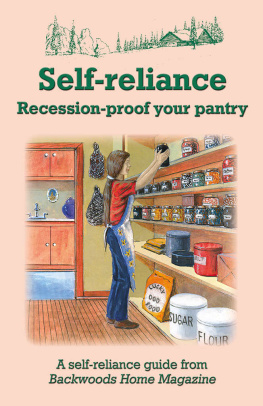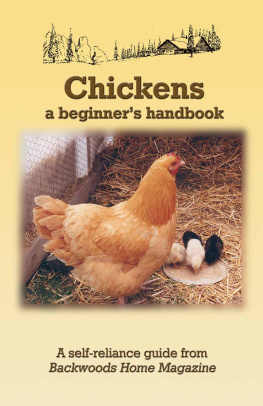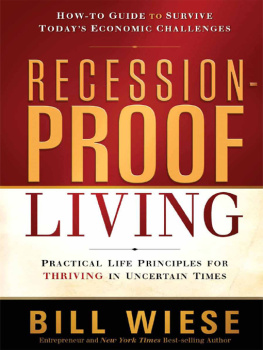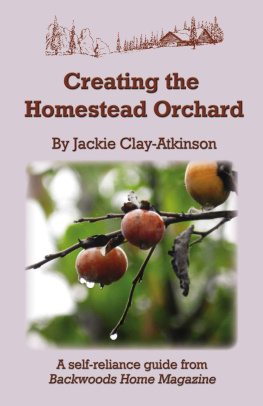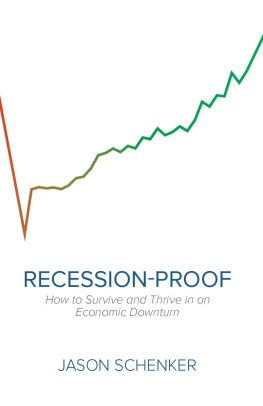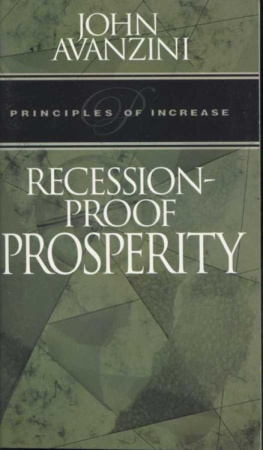Backwoods Home Magazine - Self-Reliance: Recession-Proof Your Pantry
Here you can read online Backwoods Home Magazine - Self-Reliance: Recession-Proof Your Pantry full text of the book (entire story) in english for free. Download pdf and epub, get meaning, cover and reviews about this ebook. year: 2008, publisher: Backwoods Home Magazine, genre: Home and family. Description of the work, (preface) as well as reviews are available. Best literature library LitArk.com created for fans of good reading and offers a wide selection of genres:
Romance novel
Science fiction
Adventure
Detective
Science
History
Home and family
Prose
Art
Politics
Computer
Non-fiction
Religion
Business
Children
Humor
Choose a favorite category and find really read worthwhile books. Enjoy immersion in the world of imagination, feel the emotions of the characters or learn something new for yourself, make an fascinating discovery.
- Book:Self-Reliance: Recession-Proof Your Pantry
- Author:
- Publisher:Backwoods Home Magazine
- Genre:
- Year:2008
- Rating:5 / 5
- Favourites:Add to favourites
- Your mark:
- 100
- 1
- 2
- 3
- 4
- 5
Self-Reliance: Recession-Proof Your Pantry: summary, description and annotation
We offer to read an annotation, description, summary or preface (depends on what the author of the book "Self-Reliance: Recession-Proof Your Pantry" wrote himself). If you haven't found the necessary information about the book — write in the comments, we will try to find it.
Self-Reliance: Recession-Proof Your Pantry — read online for free the complete book (whole text) full work
Below is the text of the book, divided by pages. System saving the place of the last page read, allows you to conveniently read the book "Self-Reliance: Recession-Proof Your Pantry" online for free, without having to search again every time where you left off. Put a bookmark, and you can go to the page where you finished reading at any time.
Font size:
Interval:
Bookmark:
Table of Contents
Self-reliance
Recession-proof your pantry
Contributors Jackie Clay, Jeffrey R. Yago, Sylvia Gist, Linda Gabris
Copyright 2003-2012
Backwoods Home Magazine
PO Box 712
Gold Beach, Oregon 97444
www.backwoodshome.com
Edited by Ilene Duffy, Rhoda Denning, and Lisa Nourse
Drawings by Don Childers
The Pantry
It is thrifty to prepare today for the wants of tomorrow.
from The Ant and the Grasshopper
Long-term food storage
By Jackie Clay
Y ouve decided that youre going to put at least a years worth of food away for your family just in case. Great!
Everyone should do that. We store enough to feed friends, extended family, and neighbors from time to time, as well. We could not turn down anyone who came to us saying, Im hungry. So I stock up more than most people do.

Home canning helps fill the pantry. Note decorative popcorn tins in the background, filled with dry foods.
Flours and grains
Man may not live by bread alone, but grains form the base for many meals, especially during a period of hard times. With flours and whole grains stored, you have the main ingredient for homemade pastas, breads, rolls, biscuits, pancakes, waffles, tortillas and other flat breads, pie crusts, cookies, cakes, and more.
I store unbleached (who needs bleaching compounds in their diet?) flour, at least 200 pounds, in 25-pound store bags, wrapped in plastic bags and duct tape, in Rubbermaid garbage cans with locking lids in my pantry. This will feed three of us, plus extra for friends and family, for over a year, coupled with other flour products and whole grains.
You can add any specialty flours your family likes, such as rye, amaranth, or Durham (for specialty pastas).
In addition to this flour, I like at least 100 pounds of hard wheat (sometimes called wheat berries). As ground whole wheat goes rancid fairly quickly, I like this wheat on hand to grind for all of my whole wheat recipes. In addition, whole wheat grain will grow when planted, making wheat growing on a fairly small plot possible to restock my supply. As little as a 50x50-foot plot will grow enough wheat for a small familys needs.
I also stock about 20 pounds of cornmeal, 20 pounds of masa harina de maize (corn flour) which I use to make tamales and corn tortillas, along with 25 pounds of popcorn (grinds nicely for cornmeal, as well as popping for treats), and 25 pounds of hominy corn (makes hominy and also masa harina de maize).
Rice, both brown and white, fit nicely in our storage pantry. We also store about 25 pounds of a combination of white and brown rice with a few pounds of wild rice mixed in.
And dont forget rolled oats. They are much more versatile than just using them for oatmeal. I include them in several multi-grain breads, breakfast cake, bars, meat loaf, granola, and cookies. And as for oatmeal, we like it cooked up with peaches, strawberries, and apples with cinnamon for a treat.
Any grains that are ground, especially cornmeal, masa harina de maize, and whole wheat will get rancid quicker than do whole grains, which usually stay good for many years. Even so, flours (except whole wheat flour) will stay perfectly good for five years or more if kept dry and stored in airtight and bug and rodent-proof containers.
I buy my white flour, cornmeal, etc. on sale at local supermarkets, usually just before Thanksgiving, as it is cheaper then. Otherwise, I pick it up at Sams Club or other restaurant supply houses.
I pick up whole grains from local grain farmers. Sometimes the wheat needs a bit more cleaning if dusty, but a few pours from one basket to another on a windy day ensures very clean wheat. (And my wheat is not treated with toxic fumigants in storage bins before being ground into flour, as is most wheat sold to flour mills.)
When buying flour to store, be absolutely sure the bags are completely sealed, with no flour leaking out, to prevent flour weevil problems. In areas where there is a weevil problem (webs and bugs in unsealed cornmeal and flour), some folks freeze each bag of flour for several days before wrapping and storing it in completely bug-proof containers. I have not done this, but I am exceptionally careful not to store any flour products that were not very well sealed from the processing plant, and I keep them in insect-proof containers. Remember that these moths are very small and squeeze through very tiny openings.
It is not necessary to buy flours and grains from long-term storage companies unless you fear flooding. In this case, sealed tins or buckets of flours would be a good idea. Ive had plain white flour stored for over five years, which is just as good today as it was when I bought it.
Beans and other legumes
When one thinks of long-term storage, usually dried beans come first to mind. I guess this is because they remain good for so long, are nutritious, and taste pretty darned good to boot. But, for heavens sake, dont just buy a hundred pounds of navy beans and say youre all set for whatever may come your way. All beans do not taste the same. Theres a big, big difference between a large white lima and a Jacobs cattle bean, for instance. Some taste nutty, some bland. Some cook up quickly, some require hours of cooking. Some remain firm after cooking, others get mushy and soft. Experiment with a wide variety of beans before committing to a choice.
We store about 50 pounds of combined legumes, which include pintos, Cherokee mixed cornfield beans, Jacobs cattle, Hopi black bush, navies, red kidney, and a dozen old Native American varieties, along with lentils, soup peas, black-eyed peas, and garbanzos.
Beans are a great protein source and combine well in many different dishes. Refried beans, fried dry pea patties, stews, soups, chiles, baked beans, and casseroles are just a few uses for these versatile legumes.
You can buy your beans in local markets, health food stores, and co-ops, or you can do like we do, and grow your own.
All beans store a long, long time in an airtight and bug and rodent-proof container. I keep mine in gallon glass jars and in decorative popcorn tins, right on handy shelves in the kitchen. While old beans do take longer to cook up tender, they last indefinitely; Ive grown beans from 500-year-old seeds. And if you can grow plants from seed, you can certainly eat them.
Dried pasta
While I make a lot of homemade pasta, I still keep quite a bit in our storage pantry. When youre busy with a survival situation, you may not have time to make pasta. So Ive put away 10 pounds of long spaghetti, 10 pounds of lasagna noodles, 10 pounds of wide egg noodles, 5 pounds of alphabet macaroni, 15 pounds of elbow macaroni, and a few pounds of assorted pasta noodles.
This dry pasta keeps indefinitely when stored in a dry, bug and rodent-proof container. As with my beans and other legumes, I use decorative popcorn tins and gallon glass jars.
Sugar and honey
You will probably agree with me that we all eat too much sugar. And although honey is natural and better for us than refined sugar, its still sugar. But in bad times, we usually feel better with treats from time to time. And these treats often include sugar. Also, much fruit is home canned with a sugar syrup, and if youre going to can to keep your pantry from running out in bad times, youll need quite a bit for fruits, pickles, jams, jellies, preserves, etc.
Although my husband Bob is a diabetic, we do include sugar in our storage pantry. I keep a 25-pound sack in a plastic garbage can, along with assorted other dry foods. Much of this sugar is used in canning and desserts for my son, David, and myself. Bob needs a sugar substitute.
Next pageFont size:
Interval:
Bookmark:
Similar books «Self-Reliance: Recession-Proof Your Pantry»
Look at similar books to Self-Reliance: Recession-Proof Your Pantry. We have selected literature similar in name and meaning in the hope of providing readers with more options to find new, interesting, not yet read works.
Discussion, reviews of the book Self-Reliance: Recession-Proof Your Pantry and just readers' own opinions. Leave your comments, write what you think about the work, its meaning or the main characters. Specify what exactly you liked and what you didn't like, and why you think so.

